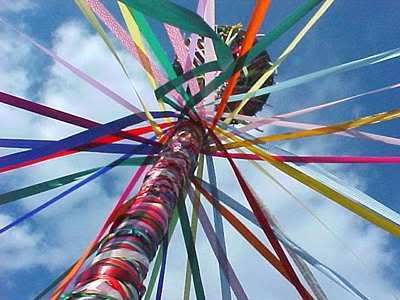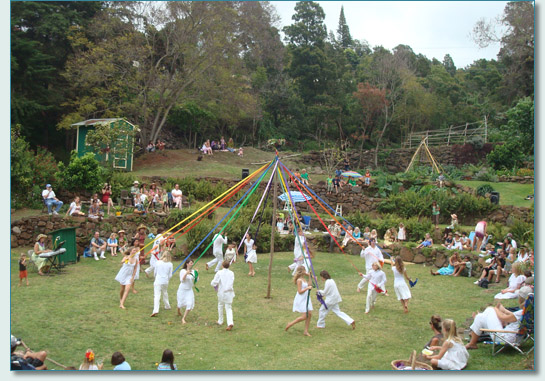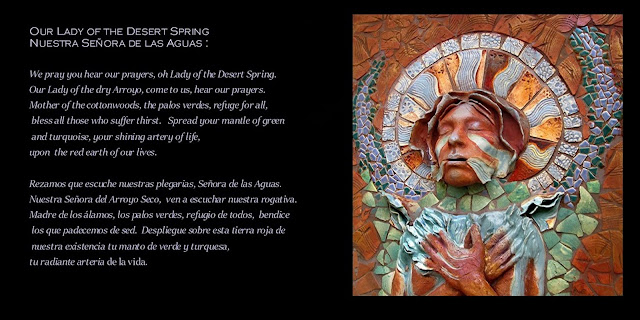Sunday, May 2, 2021
Saturday, May 1, 2021
Happy May Day!
Since Beltane (May 1) is an auspicious day with a truly ancient precedent, I can't resist a bit of his & herstory to honor the day, and a few May Pole pictures. May the RITES OF SPRING quicken the weary sap of all, may you find a bonfire to dance around, may the May Queen bless you!
The planting of the May Pole, and the union of the May Queen with the May King (or the Green Man) probably has its origins in very ancient traditions of the Sacred Marriage, going back as far as Sumeria and the marriage of Inanna and Dumuzi - or probably farther even than that, into unknown origins in prehistory. In ancient times, the spring ritual union of the King with the priestess (representing the Earth Mother) was a very significant rite; in later times, even in Christian Europe, church morality may have been suspended for Beltane, as couples went out into the fields to participate in the ripening fertility.
For myself, I think the re-sacralization of sexuality, in tandem with the blossoming of the world, that was the original meaning of May Day.....is a wonderful Holy Day, and am often surprised by how few people today know of it's origins. This has to do with the de-sacralization of sexuality that has followed closely behind the monotheistic Judeo-Christian-Islamic God - who apparently does not approve of sex, or the raucous turning of the natural year that becomes spring's fertility. Not a bad argument for polytheism, where, when there is a multiplicity of Gods and Goddesses, things are a bit more tolerant, people could pick and choose their Deities.
Traditionally, the Maypole was hung with garlands and streamers. Dancers took hold of the ends in a weaving courtship dance.




Flora was the Roman Goddess of Flowers and it’s not surprising that her festival was held on the first day of May, which also has a lot to do with the May Day of European lore. The May Dance festivals of Europe have many of their origins in the ancient “Feast of Flora”, the ecstatic Roman Rites of Spring.
"Whitman says, "And your very flesh shall be a great poem."............That is the message I'd like to offer on Beltane. Our flesh is a symbol, a microcosm of the earth we inhabit. Our flesh is what connects us to the seasons; it is where we feel the cold of winter, and -- more and more in the Northern Hemisphere -- the warmth of the sun. It is in and through our flesh that we experience our emotions. We feel love in the flesh; anger in the flesh; exuberance in the flesh. The body is a treasure trove of sensation, and our sensations inform our temporal existence. Sensation may not be all of what life is, and the experiences of the flesh may be subjective and passing. But subjectivity and impermanence do not make a thing meaningless. Flowers bloom for but a short time, and when they do they are beautiful. We bloom, too.Teo Bishop on Beltane, 5-1-2013
We are a body full of color and fragrance. We are a cycle of life unto ourselves, and we have good cause to celebrate our body -- our flesh -- for we have no knowledge of what is to come beyond this moment, this life, this body. We are here, alive, and we can, on the day and in the season of Beltane, choose to celebrate the life that we are living. We can choose to honor our flesh, and honor the flesh of others. (What a world we would live in if the flesh was not seen as evil, but rather a manifestation of something holy and worthy of respect. I wonder if violence would be so commonplace if we recognized the flesh as sacred.)
Love the body you are in! Love your flesh! Celebrate this High Day with a fullness of being!!"
Tuesday, April 20, 2021
"Our Lady of the Shards"..............Remembering Buried Lives
 |
| "The Memory Keeper" and "Our Lady of the Forgotten Midwives" (2019) |
 |
| The Bone Goddess (2018) |
 |
| "Our Lady of the Waters" (2014) |
Saturday, April 17, 2021
She Who Hears the Cries of the World
 |
| Mana Youngbear as "White Tara" in Restoring the Balance (2004) |
SOUND POEM BY LAUREN RAINE (2019)
to listen:
https://soundcloud.com/user-972033003/white-tara-by-lauren-raine
White Tara is the manifestation of complete Compassion, She is the Bodlhissatva who will assist the suffering of the world, assist us to move through the suffering to love, and the reealization that we are not alone, that we all belong to the great Circle. Quon Yin, Tara, Mother Mary.............. all manifestations or archetypes of the Divine Mother, and the expansion of unconditional compassion and love. I wrote this spoken word poem in 1997, when I was going through loss of a home/dream/community that eventually led me to create a new life on the other side of the continent.
I reflect, as I try to recall the experience from which this poem arose, that the opening of the heart that grief and loss can bring can also be a path into profound evolutionary change, but in my experience, to grow one must first go through it, one must experience the pain and the loss.
Which is something very fearful to do, and can take a long time to do. Because the heart does not know or reason in sequential time like the intellect does! Having just lost a beloved cat, I am experiencing this right now. The emotional body, it seems to me, suffers all the losses at once as each loss arises. And the heart also partakes in a greater Mystery that somehow knows all beings are One, remembering all experiences of love and belonging within the Circle dance of life. Grief can be a great teacher.
"I went to meet that savage creature I have run from, lifetime after lifetime,
the shape within the shadows, huge, a creature of smoke and bared fangs. "
This line arose from a dream I had many times, in which I was being pursued by a vampire. Always it almost got me, or was a shadowy presence just behind me, and I would wake up. I suppose Jungians would call this the "denial of the shadow" or some such. I was always too afraid to confront the creature that pursued me in those dreams, because I was sure it would kill me. Finally I had a dream in which I became tired of running, and a I stopped to face the pursuing monster. And when, at last, the horror embraced me it turned into a young boy, vulnerable, with tears in his eyes.
Tuesday, April 6, 2021
Saraswati Synchronicity (and a poem)
"Author Lauren Raine wrote, 'I've often had the experience, especially with the Internet, of having information I needed come to me. I even am not surprised any more, having faith in some kind of invisible means of support. I remember in 2000 when I was working on descriptions of Goddesses for my book, receiving several emails out of the blue, from someone I didn't know, that discussed eloquently the Goddess Saraswati. Which was information I needed. I still have no idea of who that person was who sent me those articles, or why, or even where they got my email address from.' " (page 139)
I had completely forgotten about that, but it's true that often I received help with my Goddess projects that did seem to come from "an invisible means of support". I must have emailed the story to the MacGregors, and they shared it with Dr. Beitman. But what are the odds of opening my new book to the exact place where my own 20 year old story of synchronicity is?
So, I have been thinking about it ever since, and felt like sharing it here. Specifically I've been thinking about Saraswati, Her presence in Bali which I strongly felt when I was there, the masks I've made for Her over the years, and what gifts the Goddess brings to those who ask.
Saraswati is the Hindu Goddess of Art, Language, Communication, Knowledge, Learning, and creative Inspiration. She is often portrayed with instruments in her hands, demonstrating the tools of art and expression. In India the Goddess is sometimes invoked at the birth of a child, and a bit of honey is placed on the infant's tongue so he or she will be "blessed with good speech". When I was in Bali (which is also when I wrote the below poem) I understood that Saraswati was very important to the Balinese people. I remember once seeing a flock of geese making their way up a street, with a whole line of mopeds behind them. When I asked a Balinese friend why no one moved them out of the way, she responded: "Sacred to Saraswati". That was apparently answer enough.
According to Wikipedia, Saraswati is:
"Originally associated with the great river known as Saraswati..........(the name) also means "she who has water" and "she who possesses speech". It is also a Sanskrit composite word of surasa-vati (सरसु+अति) which means "one with plenty of water". The word Saraswati appears both as a reference to a river and as a significant deity in the Rigveda. In initial passages, the word refers to the Sarasvati River .................the Rigveda describes Saraswati as the best of mothers, of rivers, of goddesses."
".......Her importance grows in Vedas composed after Rigveda and in Brahmanas, and the word evolves in its meaning from "waters that purify", to "that which purifies", to "vach (speech) that purifies", to "knowledge that purifies", and ultimately into a spiritual concept of a goddess that embodies knowledge, arts, music, melody, muse, language, rhetoric, eloquence, creative work and anything whose flow purifies the essence and self of a person. In Upanishads and Dharma Sastras, Saraswati is invoked to remind the reader to meditate on virtue, virtuous emoluments, the meaning and the very essence of one's activity, one's action."
I can't help but think that that provides an excellent description of "Sacred Arts", which might be viewed (also, along with geese or swans) as "Sacred to Saraswati". I reflect also that what profoundly impressed me when I was in Bali was the presence, and practice, of art absolutely everywhere, within everyone's lives. Not in any western sense - all arts there were done as a religious offering, as communal and devotional. Everyone is engaged in some way, whether that is participating in the music or masked dramas, as dancers, making the elaborate offerings for rituals and celebrations, painting.......the making of art is everywhere, a part of daily life. The Balinese have no idea of the "great alienated artist" and they have no discourse about the "meaning of art". I remember again what a revelation that was to me, and that also later inspired me to offer my masks as "Temple Masks for the Goddess" when I returned from Bali.
One other word about the "River Saraswati": there is no actual Saraswati River in India - the great purifying river of Saraswati is rather a spiritual or metaphorical river that sustains the soul rather than the body. To bathe in, or seek pilgrimage to, the river Saraswati (like the pilgrimages made to the actual river Ganges) is to be purified, to be given highest inspiration and vision, and to join with the great beauty and mystery of life. So it seems to me.
The poem below I wrote when I was in Bali, actually, when I stood looking across a valley at the great volcano Kintamani. A body of water was beneath it. For a long time I used a false Balinese name as the author, because it has a Balinese "voice". But it came from my heart, and my response to this "Land of Saraswati".
Love is Saraswati's river
flowing through our lands.She will feed the rice fields,She will accept our woven offerings.She will bear our ashesand the fires of Kintamanito the sea.Formless, she neither takes nor gives;we impose these significancesupon the flowers we cast in her.From birth to death,Saraswati's river sustains us to the sea.
(2000)
Monday, March 29, 2021
"The Forest Man" - Real Green Men for the 21st Century
 |
| "The Green Man" from 1997 Rites of Spring ritual |
The Green Man is an almost universal archetype of the renewal of life in the spring, and it is, of course, beloved by contemporary neo-Pagans as well, symbolizing manhood as re-newer and re-generator instead of as "warrior", which so often becomes authoritarian destroyer in a patriarchal, dominator, "alpha male" based culture (and this includes "dominating" nature, instead of working with nature).
Below is a wonderful documentary that I ran across almost by accident, about a man in India who single handedly, and with extraordinary dedication, planted a thriving forest, beginning his work in 1979. His story began my search for other "Forest Men". To watch and listen is to be not only inspired, but to feel hope. Because I believe that this is what the future civilization will have to look like, these technologies of love, sustainability, Earth based science and spirituality, along with new and old ways for human beings to cooperate and get along with each other. I believe, instead of vast space stations and digital robots and endless wars, the future will have to look more like a forest, or a garden, if there is to be a future civilization at all.
And the message Jadav Payeng (and the others I have, through the grace of UTube, been able to share here) carries is that renewal can happen when humans become stewards of the land, and let Nature do what nature does, assisting in simple ways, like planting trees, or allowing environmental diversity to be protected enough to return. These regenerated forests and deserts truly offer us hope.
I am reminded of a book by Alan Weisman called THE WORLD WITHOUT US, in which the author researched areas around the world that had become abandoned or off limits to people, like the neutral or demilitarized zone between North and South Korea - and the extraordinary renewal that took place in such environments. There was also a 2008 television documentary called "Life After People" that explored the same theme.
Since, as I mentioned in the previous post, I can't think of what to say of late, I will let these people speak on this Blog instead. They are true Green Men.
Jadav Payeng, Majuli Island, IndiaJohn D. Liu*, Re-greening the desert
Friday, March 26, 2021
The Old Dog Still Knaws at the Art World
 |
| "The Green Man" (2021) |
"The artistic notion of the 'death' of painting needs little introduction. It has shaped the course of twentieth century art, and affected the lives and practices of millions of artists in fundamental ways, but the model of the human mind upon which it implicitly rests is no longer considered to have useful relevance in the twenty-first century. Cognitive science and evolutionary psychology have concluded that the mind is not a blank slate but content-rich at birth, and as such humans bear an array of innate expectations of reality and non-reality, many of which apply as much to the artform of painting as they do other cultural behaviours and expressions such as religion or music. This eclectic and creative thesis takes in a diverse series of case studies tracing the prehistory of painting in light of these cognitive propensities, from the beginnings of human culture in Southern Africa to abstract designs and hand-prints in the Palaeolithic caves, from Bushman rock art depicting swift-people to the reported experiences of painters living today, to uncover a perennial and foundational function for painting which cannot die: the ubiquitous sensation of an 'otherworld' beyond the surface of the canvas or rock face. This simultaneously new and ancestral approach to painting demands a rehabilitation of the medium as both a humanising self-expression and as beyond-the-self exploration in a modern art context increasingly estranged from the wider world. Painting as 'Liminal Contact' seeks to abandon artistic ideologies and limiting art theories of what is possible in favour of a direct image-based communion with human nature. "



















